Style history
The Kabiria vases are the main style of black-figure vases from Boeotia. Their modern name is derived from the sanctuary of the Kabiria near Thebes, where the majority of such vases were found. They are also known from the graves of the Theban warriors fallen in the Battle of Chaironeia in 338 BC. The shapes painted in the style are usually skyphoi , and sometimes hemispherical kantharoi with vertical ring handles. Some shapes, such as lebes are totally absent, other, such as kylikes and pyxidai occur rarely. The vessels were produced from about 425/420 until 250 BC or a bit later. They depict cult scenes, usually caricatures of mythological events. There are also scenes depicting the symposia that took place at the sanctuary. The type's main characteristic is the humorous and exaggerated style of painting, although it is not present on all the vases, as more serious depictions of cult life also occur. The bulk of the vases is, in fact, decorated only with plant ornaments. Many are only painted on the front. Scholars recognise the hands of several individual artists, including the Mystai painter.
[[File:Kylix 61.7 with Helen and Hermes, ca. 420 BC, part of the Vassil Bojkov collpe was the kantharos, with a narrower and deeper cup and high vertical handles.

Black-figure pottery painting, also known as the black-figure style or black-figure ceramic is one of the styles of painting on antique Greek vases. It was especially common between the 7th and 5th centuries BC, although there are specimens dating as late as the 2nd century BC. Stylistically it can be distinguished from the preceding orientalizing period and the subsequent red-figure pottery style.

Red-figure vase painting is one of the most important styles of figural Greek vase painting.

Lydos was an Attic vase painter in the black-figure style. Active between about 560 and 540 BC, he was the main representative of the '’’Lydos Group’’’. His signature, ό Λυδός, ho Lydos, the Lydian, inscribed on two vases, is informative regarding the cultural background of the artist. Either he immigrated to Athens from the Lydian empire of King Kroisos, or he was born in Athens as the son of Lydian parents. In any case, he learned his trade in Athens.
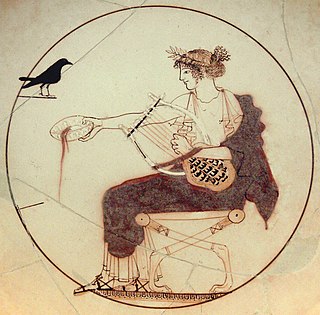
White-ground technique is a style of white ancient Greek pottery and the painting in which figures appear on a white background. It developed in the region of Attica, dated to about 500 BC. It was especially associated with vases made for ritual and funerary use, if only because the painted surface was more fragile than in the other main techniques of black-figure and red-figure vase painting. Nevertheless, a wide range of subjects are depicted.
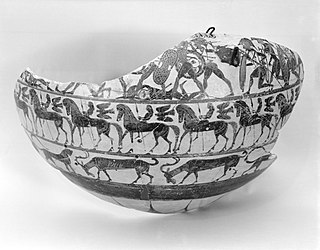
The Cavalcade Painter is the conventional name for an ancient Greek vase painter who produced Corinthian black figure vases. He was active during the Middle Corinthian period, around 580 BC.

Tyrrhenian amphorae are a specific shape of Attic black-figure neck amphorae. Tyrrhenian amphorae were only produced during a short period, about 565 to 550 BC. They are ovoid in shape and bear striking decorations. The handle is usually decorated with a lotus-palmette cross or vegetal tendrils. It always terminates in a red-painted ridge. The vase body is painted with several friezes. The uppermost of these, on the shoulder, is usually especially notable. It often contains mythological scenes, but the first erotic motifs in Attic vase painting also occur here. Unique motifs include the sacrifice of Polyxene. Often, the figures are explained by added inscriptions. The other friezes, usually two to three in number, are often decorated with animals. At times, a frieze is replaced with a vegetal band.

A Nikosthenic amphora is a type of Attic vase invented in the late 6th century BC by the potter Nikosthenes, aimed specifically for export to Etruria. Inspired by Etruscan Bucchero types, it is the characteristic product of the Nikosthenes-Pamphaios workshop.

The Leagros Group was a group of Attic black-figure vase painters active during the last two decades of the 6th century BC. The name given to the group by modern scholars is a conventional one, derived from a series of name vases.

Bilingual vase painting is a special form of ancient Greek vase painting. The term, derived from linguistics, is essentially a metaphorical one; it describes vases that are painted both in the black-figure and in the red-figure techniques. It also describes the transitional period when black-figure was being gradually replaced in dominance by red-figure, basically the last quarter of the 6th and the very beginning of the 5th century BC. Their appearance may be due to the initial uncertainty of the market for the new red-figure style, although that style subsequently became dominant rather fast.
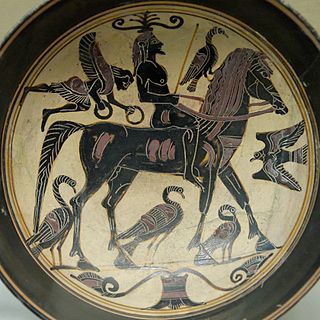
Laconian vase painting is a regional style of Greek vase painting, produced in Laconia, the region of Sparta, primarily in the 6th century BC.

Boeotian vase painting was a regional style of ancient Greek vase painting. Since the Geometric period, and up to the 4th century BC, the region of Boeotia produced vases with ornamental and figural painted decoration, usually of lesser quality than the vase paintings from other areas.
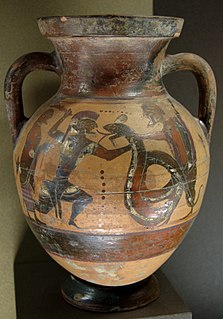
Euboean vase painting was a regional style of ancient Greek vase painting, prevalent on the island of Euboea.
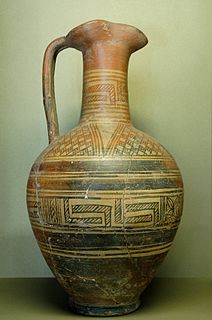
East Greek vase painting was a regional style of ancient Greek vase painting, produced by the eastern Greeks. In spite of the region's wealth, the pottery was rather unremarkable in comparison to other areas. The clay is red-brown to pink and often contains mica inclusions. Many regional sub-styles of East Greek pottery existed.

The Pontic Group is a sub-style of Etruscan black-figure vase painting.

Etruscan vase painting was produced from the 7th through the 4th centuries BC, and is a major element in Etruscan art. It was strongly influenced by Greek vase painting, and followed the main trends in style over the period. Besides being producers in their own right, the Etruscans were the main export market for Greek pottery outside Greece, and some Greek painters probably moved to Etruria, where richly decorated vases were a standard element of grave inventories.

Ionic vase painting was regional style of ancient Greek vase painting.

Campanian vase painting is one of the five regional styles of South Italian red-figure vase painting. It forms a close stylistic community with Apulian vase painting.

Klazomenian vase painting was a regional style of ancient Greek vase painting, belonging to the East Greek representations of that form of art.
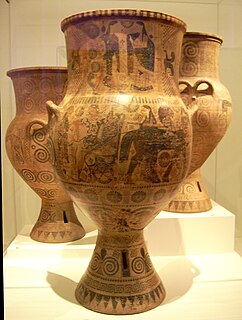
Melian Pithamphorae or Melian Amphorae are names for a type of large belly-handled amphorae, which were produced in the Archaic period in the Cyclades. On account of their shape and painted decoration in the Orientalising style, they are among the most famous Greek vases. The amphorae are dated to the seventh and early sixth centuries BC; the last of them was made in the 580s. They were used as grave markers with the same function as the later grave statues and reliefs and were dedicated as cult objects in sanctuaries. With the increasing importance of sculpture in these roles, the production of these vases came to an end.



















